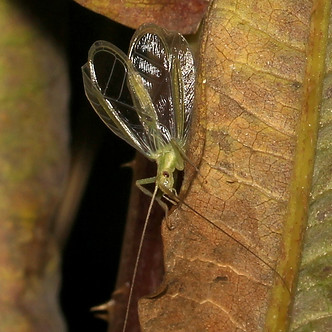Why do they sing at night? Don’t they also sing during the afternoon?
Katydids and crickets make very fine meals for many species of birds, mammals, reptiles, and amphibians. While insect songs advertise to females, they can also call to predators as well. If you’ve watched birds searching for insects to eat, you’ve probably noticed that they are very skillful, resourceful hunters. Many katydids and crickets sing at night because most birds simply are not hunting for food at that time.

Eastern Bluebird brings a Northern Green-striped Grasshopper back to the next box.

Four-spotted Tree Cricket singing at night
Species that sing in the afternoon as well as at night seem especially well-suited for hiding. Ground crickets and field crickets, for example, are literally on the ground, under plants, in leaf litter and twigs, under rocks, and other inaccessible places. (You’ll discover just how inaccessible if you try searching for them yourself.) They will sing in the afternoon and even more enthusiastically after dark.

Male Striped Ground Cricket nymph
The small meadow katydids sing during the afternoon, hidden among grasses, sedges, and cattails. The larger katydids that are impressive leaf mimics don’t sing as often in the day as at night. Well-hidden during the day, they move so little or so gradually that they seem to be just another leaf on their plants.


Broad-winged Bush Katydid hides in the sedges by day and is on display at night.
There are insects – especially crickets – who either primarily or exclusively sing at night when they first mature but subsequently, sing in the later afternoon as their season progresses. Shorter days and longer, colder nights necessitate daytime song because it may get too cold at night for them to sing at all. There are some crickets, however, who never sing during the day and others who only sing once their meadows are in the shade.


Four-spotted Tree cricket singing at night on August 3rd and in the afternoon on September 26th
Listen for singing insects primarily after dark in mid to late July into the first few weeks of August, then focus listening on warm, sunny afternoons from the end of August through September. Just keep in mind that a warm, humid night can trigger a sudden resurgence of the nocturnal chorus even well into September or early October if there has not been a freeze.
Here’s an interesting sound experiment for late July into August. Listen to how quiet the meadows, ponds, and edge habitats become an hour or so before sunset. While I can only speculate, it seems as if the katydids and crickets are very quiet as birds make one last trip for an evening snack.
Then as dusk approaches, you’ll notice first, one, then two, then three more species begin to sing. Soon a few more will join them. It is enchanting to listen to the sections of the ensemble begin until the entire chorus is in full song.